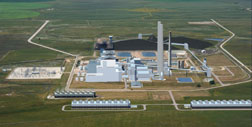 Sunflower Electric Power Corp.
Kansas regulators denied plant expansion, depicted in artist’s rendering.
|
“We’re going to go meet with some legislators to try and figure it out,” says Steve Miller, spokesman for the Hays, Kan.-based Sunflower Electric Power Corp., a cooperative of six utility companies. Miller says the group also is reviewing legal options. It has 15 days to appeal the decision.
The $3.6-billion project aimed to expand Sunflower’s existing 10,000-acre Holcomb campus with two new plants powered by Powder River Basin low-sulfur coal. The fuel would be pulverized and burned inside supercritical steam-turbine generators. Sunflower’s Holcomb expansion would be managed by San Francisco-based Bechtel Corp.
Permit reviewers recommended approving the deal, but the state came up against intense environmental pressure from such groups as the Sierra Club, which filed two lawsuits opposing the project. Kansas Dept. of Health and Environment Secretary Roderick L. Bremby ultimately denied the request, citing climate-change concerns and the Supreme Court’s April 2 decision in Massachusetts v. EPA that carbon dioxide is an air pollutant.
“I believe it would be irresponsible to ignore emerging information about the contribution of carbon dioxide and other greenhouse gases to climate change,” says Bremby.
Sunflower President and CEO Earl Watkins called the decision “arbitrary and capricious,” positioning the operator to file a legal action against the state based on loose interpretation of the law, should other remedies fail. Whether or not Sunflower can sidestep the administrative appeals process and go straight to court is still a “question that we are not sure of,” says a KDHE spokesman.
Other industries, including cement, are watching the decision closely. Cement plants emit about one ton of carbon dioxide per ton of material produced. Half of those emissions come from burning coal and natural gas to heat clay and limestone into clinker. The balance comes from the natural calcination of those materials in the kiln.
“We’ve made considerable strides in improving efficiency,” says Andy O’Hare, vice president of regulatory affairs for Skokie, Ill.-based Portland Cement Association. “But one thing we can’t do is reduce our emissions in absolute terms without also reducing the amount of cement we produce.” Applying the same loose interpretation of the Supreme Court ruling to new cement plants, he says, would force manufacturers to import more of what is already a construction material in high demand. “We’re confronting a crescendo on this whole [climate-change] thing,” O’Hare adds. “And I think it will all coalesce with some kind of legislation in Washington.”
The Sierra Club hailed KDHE’s action as a “monumental global-warming victory.” Kansas Gov. Kathleen Sebelius (D) likewise says the state “must take advantage of renewable energy and conservation as we progress through this century.” The decision is the first air- quality permit for a powerplant denied on the grounds of the Supreme Court decision.
Even though the Supreme Court ruled that the Environmental Protection Agency must regulate greenhouse-gas emissions of automobiles, regulators in several states, including Kansas, are interpreting the decision to include a wider range of emission sources. Sunflower and other industrial groups argue that EPA does not yet regulate carbon dioxide, so they shouldn’t be denied air-quality permits on those grounds.
Sierra Club calls the move to build plants before regulations come into play a “coal rush.” Its members say Kansas’ decision, if upheld, would become the grounds for them to oppose the 100 or so other coal plants planned in the U.S.
“Climate change has just thrown a wrench into the power industry,” says Bill Griffith, energy and legal chairman for the Sierra Club’s Kansas chapter in Leavenworth. “I think some good things are going to come out of it. But there are going to be some convulsions.”
Environmental groups hope to push power operators like Sunflower to step up alternative energies in place of traditional, “dirty” coal. The Holcomb plans call for a mix of new and old technologies. Water supply would be drawn from the region’s Ogallala aquifer at a rate of 8,000 acre-ft per year. The powerplants would mitigate nitrogen oxide, sulfur oxide and particulate emissions with selective catalytic reduction, dry-line flue-gas desulfurization and fabric-filter baghouse units. A 360-MW plant sits on the site today.
Sunflower proposed building a biofuel-producing algae reactor powered by the plants’ carbon emissions, but opponents argue that the campus would still produce 11 million tons more carbon emissions every year. The Holcomb expansion would make Sunflower one of the top three new greenhouse-gas polluters in the country, notes Sierra Club.
In its decision, KDHE favors a cap-and-trade program that would reduce carbon pollution by 10%, or 12 million tons annually, by 2020. Local environmentalists are also pushing for a mix of natural-gas and wind-power infrastructure in prairie-rich Kansas, which wind-energy proponents often call the “Saudi Arabia of the U.S.”
“We are forcing them to go to wind,” says Griffith. “If in five to seven years, wind is not the answer, we could have some egg on our face. But I don’t think that is going to happen.” Environmental groups have not yet ruled out “clean coal” alternatives. “Right now, we are skeptical,” Griffith adds.
n electric utility operator that is trying to build two new 700-MW coal-fired plants in Holcomb, Kan., says it plans to challenge the state’s Oct. 18 decision to deny an air-quality permit based on global warming concerns. Left hanging are more than 100 other proposed coal-fired plants across the U.S. whose fates may rest in the expansive prairie of western Kansas. Sunflower says the fight is not over. “It’s not going to be nuclear, so if it can’t be coal then it’s going to have to be gas or something else,” says Miller. “But that’s not something we are ready to concede yet.”
Post a comment to this article
Report Abusive Comment